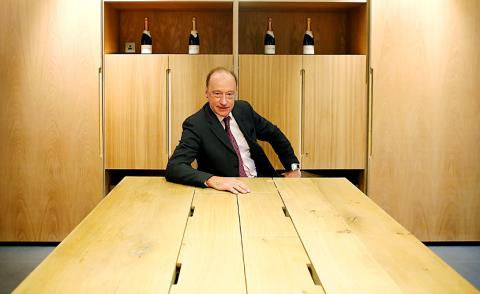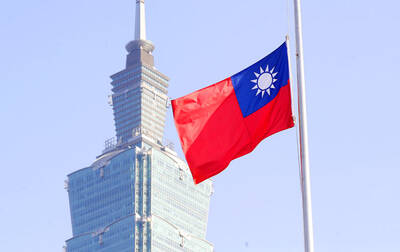With revelers raising a glass of bubbly to the new year, England’s tiny sparkling wine industry is set for a lift this year as established brands step up export plans and newcomers join the party.
Internationally, England may be known for its ale, cider and gin, but it is also home to 432 vineyards and 124 wineries. These sit mostly along the southeast coast, which has a similar geology and climate to France’s Champagne region across the English Channel.
English sparkling wine remains a drop in the bucket compared with its continental cousins, but producers are determined to hang on to their premium positioning, selling at an average of £25 (US$40.89) a bottle, even as many cost-conscious Britons turn from champagne to cheaper cava from Spain and prosecco from Italy.

Photo: Reuters
“We see ourselves as a luxury brand and we have to be judged on a world stage, not just an English stage,” said Julian Kirk, who is in charge of sales at West Sussex winemaker Nyetimber, one of the longest-established names in English sparkling wine and owner of 10 percent of the country’s vineyards.
“The British market is great, but we can’t depend on it for the long-term future,” Kirk added.
Those efforts have made the wine community sit up and take notice in recent years, earning British bubbly more than its fair share of awards.
Among them was East Sussex winemaker Ridgeview’s triumph at the 2010 Decanter World Wine Awards over several other, more illustrious champagne producers.
English sparkling wines punched above their weight again this year, with three gold medals in the prestigious International Wine Challenge. The winners were: Nyetimber, Gusbourne Estate in Kent and Dorset producer Furleigh Estate.
It should therefore come as no surprise that Nyetimber began exporting to Japan in May and Denmark in September last year.
With more than two decades of production under its belt since the 1992 debut vintage, Nyetimber is likely to start selling in the US this year and is also eyeing Singapore, Hong Kong, Australia and Denmark’s Nordic neighbors, Kirk said.
In 2012, 55,000 nine-liter cases of English sparkling wine were sold in its home market, according to wine data specialist International Wine & Spirit Research (IWSR), representing a compound annual growth of 13 percent over the past five years.
That gave the alcoholic drunk 0.6 percent of the 9.1 million cases of bubbly sold in Britain last year.
Spain, France and Italy together control 87 percent of the market, although Spain recently pulled ahead of France because of the popularity of cava as a low-cost enjoyable sparkling wine, IWSR’s Helen Windle said.
The researcher predicts that sales of sparkling wine will grow faster than any other wine category in Britain over the next few years, adding 1.7 million cases between 2012 and 2018 at a compound annual growth rate of 2.8 percent.
For champagne makers such as LVMH, Pernod Ricard and Laurent Perrier, there has been increasing speculation that they might be looking to purchase vineyards in Britain, their biggest export market.
“If we have the time, will and passion, it’s possible [to make great sparkling wine in England],” said Pierre-Emmanuel Taittinger, president of the champagne house that bears his family name, although he said it has no such plans at present.
Julia Trustram Eve, marketing director for the English Wine Producers trade group, said that the winemakers must retain their focus on quality.
Even though part of this comes from the cool weather that gives the grapes high acidity, it is also down to the traditional production method, in which second fermentation takes place inside each bottle, rather than in bulk tanks.
“It’s in our interest to make sure that anyone involved in the industry and the production of this premium wine is going to keep to those levels of quality, for the sake of our own reputation,” she said.
Digby Fine English, one of the newest English winemakers, is sticking to that strategy. Its first vintage, 2009, has just gone on sale at upmarket outlets such as Selfridges department store and Michelin-starred restaurants.
Trevor Clough, Digby’s corporate strategist-turned-CEO, said that the industry’s small size helps to support its premium price as it slowly but surely builds its reputation.
“We’re not really at the point where we want everyone to know and everyone to want to buy English wine all the time,” Clough said. “It’s all about focusing on early adopters and cultivating their enthusiasm.”

When Lika Megreladze was a child, life in her native western Georgian region of Guria revolved around tea. Her mother worked for decades as a scientist at the Soviet Union’s Institute of Tea and Subtropical Crops in the village of Anaseuli, Georgia, perfecting cultivation methods for a Georgian tea industry that supplied the bulk of the vast communist state’s brews. “When I was a child, this was only my mum’s workplace. Only later I realized that it was something big,” she said. Now, the institute lies abandoned. Yellowed papers are strewn around its decaying corridors, and a statue of Soviet founder Vladimir Lenin

ELECTRONICS BOOST: A predicted surge in exports would likely be driven by ICT products, exports of which have soared 84.7 percent from a year earlier, DBS said DBS Bank Ltd (星展銀行) yesterday raised its GDP growth forecast for Taiwan this year to 4 percent from 3 percent, citing robust demand for artificial intelligence (AI)-related exports and accelerated shipment activity, which are expected to offset potential headwinds from US tariffs. “Our GDP growth forecast for 2025 is revised up to 4 percent from 3 percent to reflect front-loaded exports and strong AI demand,” Singapore-based DBS senior economist Ma Tieying (馬鐵英) said in an online briefing. Taiwan’s second-quarter performance beat expectations, with GDP growth likely surpassing 5 percent, driven by a 34.1 percent year-on-year increase in exports, Ma said, citing government

UNIFYING OPPOSITION: Numerous companies have registered complaints over the potential levies, bringing together rival automakers in voicing their reservations US President Donald Trump is readying plans for industry-specific tariffs to kick in alongside his country-by-country duties in two weeks, ramping up his push to reshape the US’ standing in the global trading system by penalizing purchases from abroad. Administration officials could release details of Trump’s planned 50 percent duty on copper in the days before they are set to take effect on Friday next week, a person familiar with the matter said. That is the same date Trump’s “reciprocal” levies on products from more than 100 nations are slated to begin. Trump on Tuesday said that he is likely to impose tariffs

HELPING HAND: Approving the sale of H20s could give China the edge it needs to capture market share and become the global standard, a US representative said The US President Donald Trump administration’s decision allowing Nvidia Corp to resume shipments of its H20 artificial intelligence (AI) chips to China risks bolstering Beijing’s military capabilities and expanding its capacity to compete with the US, the head of the US House Select Committee on Strategic Competition Between the United States and the Chinese Communist Party said. “The H20, which is a cost-effective and powerful AI inference chip, far surpasses China’s indigenous capability and would therefore provide a substantial increase to China’s AI development,” committee chairman John Moolenaar, a Michigan Republican, said on Friday in a letter to US Secretary of